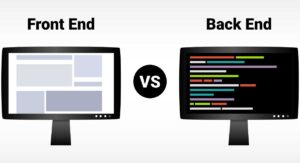The best way to ace an interview is to be prepared for the questions. By this, we mean that knowing the information isn’t enough; you can trip yourself up and come up blank when asked a question, even if you know the answer. Preparation takes much of the pressure off and makes it easier to recall information. That’s what this article is here for.
AngularJS is a popular web development tool, and you may find yourself in an interview for a development position that uses this framework. It helps to be ready for it and understand what questions you may face.
This article provides you with the most asked AngularJS interview questions and answers. The article breaks down the questions by experience level, from beginner to advanced. We’ll also share a full stack web development program you can take to prepare yourself better.
Let’s begin with 40 AngularJS questions and answers for beginners and entry-level positions.
Beginner AngularJS Interview Questions and Answers
Q: What is AngularJS?
A: AngularJS is an open-source JavaScript framework that creates single web page applications. AngularJS lets you use HTML as the template language. It enables you to extend HTML’s syntax to express application components clearly.
Q: When was AngularJS introduced?
A: AngularJS, also known as Angular 1.0, was released by Google in 2010. Version two was released in September of 2016.
Also Read: A Guide to Software Engineer Interview Questions
Q: What’s the difference between AngularJS and Angular?
A: Here are the main differences between AngularJS and Angular.
| AngularJS | Angular |
| Uses JavaScript to build applications | Uses TypeScript to build applications |
| Isn’t a mobile-friendly framework | Is a mobile-friendly framework |
| Isn’t easy to create SEO-friendly app development | Is easy to create SEO-friendly app development |
| Based on MVC architecture | Based on the Service/Controller architecture |
| Code is written with ES5, ES6, and Dart | Code is written with ES5, ES6, and TypeScript |
| Works on client-side, like JavaScript and HTML | Works on server and client sides |
Q: What is an Angular framework?
A: Angular is an open-source JavaScript framework maintained by Google and written in TypeScript. Angular’s primary purpose is developing single-page applications. Angular provides a standard structure for developers, empowering users to create large applications sustainably and maintainably.
Q: List the key features of AngularJS.
A: The key features are:
- Controller
- Data Binding
- Directives
- Filters
- Model
- Scope
- Services
- Testable
- View
Q: List the components in AngularJS architecture.
A: The basic building blocks are:
- Components
- Data binding
- Dependency injections
- Directives
- Metadata
- Modules
- Services
- Templates
Q: What are the advantages of AngularJS?
A: These are the primary advantages of AngularJS:
- It lets users create a single-page application
- It follows the MVC design pattern
- It has predefined form validations
- It supports animations
- It’s open-source
- It’s cross-browser compliant
- It supports two-way data binding
- Its code is unit-testable
Q: And what are the drawbacks of AngularJS?
A: The chief drawbacks are:
- It depends on JavaScript
- Since it’s a JavaScript-based framework, it isn’t safe to authenticate the user only through AngularJS
- It isn’t easy to learn
- Browsers on older systems and mobile devices either cannot render AngularJS framework-designed web pages and apps, or it takes longer to load
Q: What is data binding in the context of AngularJS?
A: Data binding automatically synchronizes data between view and model components.
Also Read: Understanding Front-end vs. Back-end Development: Career Guide 2024
Q: Where can you implement DOM in AngularJS?
A: You can implement DOM in controllers, directives, and services.
Define scope as it relates to AngularJS.
A: Scope is a unique JavaScript object that joins the controller (JavaScript) with views (HTML). The controller sets the properties on the scope; the view binds to them.
Q: Describe MVC as it relates to AngularJS.
A: AngularJS is based on MVC frameworks. MVC stands for Model-View-Controller and has the following characteristics:
- The Model is the lowest pattern level responsible for maintaining data
- The View is the HTML that is responsible for displaying the data
- The Controller is responsible for Views with the logic to manipulate the data. The Controller is basically a software code used for taking control of interactions between the Model and View.
Q: Is AngularJS compatible with all current browsers?
A: Yes, it is.
Q: Explain scope hierarchy.
A: Every AngularJS application has a single root scope. Child controllers, on the other hand, create scopes for each view. When new scopes are created, they are called child scopes and added to the parent root scope, resulting in a hierarchical structure when child scopes are attached.
Q: What’s data binding, and what’s the difference between one-way and two-way data binding?
A: Data binding is the automatic data synchronization between the model and view. Angular JS relies on two-way data binding, meaning the scope variable changes value whenever its model binds to a different value. One-way binding is where the HTML scope variable is set to the first value the model is assigned to.
Q: Define directives and list the different types.
A: Directives are unique markers on DOM elements that order the HTML compiler to attach a specified behavior to the DOM element. All directives begin with the ng-prefix, and some of the most often used directives in AngularJS applications include ngApp, ngBind, ngClass, ngRepeat, ngModel, and ngInit.
Q: What are AngularJS templates?
A: Templates are rendered views featuring information from the controller and model. Templates can be a single file (e.g., index.html) or multiple views on one page using “partials”.
Q: What are Angular expressions?
A: Angular expressions are code snippets typically placed in binding. For example: {{ expression }}.
Q: What is a Single-Page Application?
A: A single-page application, also known as SPA, is a website or a web application that dynamically interacts with the users, rewriting the current page rather than loading the whole page from the server.
Q: Summarize the AngularJS boot process.
A: The HTML document gets loaded into the browser and evaluated.
- The AngularJS JavaScript file is then loaded, creating the angular global object. JavaScript then runs and registers all controller functions.
- AngularJS scans through the HTML, looking for AngularJS apps and views. When a view is located, it connects it to the corresponding controller function.
- Finally, AngularJS executes all controller functions, rendering the views with data from the model populated by the controller. Then, the page gets ready.
Now, let’s check out a similar number of AngularJS advanced interview questions and answers.
Advanced AngularJS Interview Questions and Answers
Q: What are templates in AngularJS?
A: Templates are HTML files filled or enriched with AngularJS items like directives and attributes. Directives are essential to specify a particular attribute or class to discern its behavior according to the user’s needs.
What’s Angular Material?
A: It is a user interface (UI) component library that helps designers build an attractive, functional web application and pages while following web design principles like browser portability, device independence, and graceful degradation. It helps create responsive and attractive websites.
Also Read: All About the Software Development Life Cycle
Q: What is transclusion?
A: Transclusion lets you shift the original children of a directive to a specified location within a new template. The ng directive points to the insertion point for a transcluded DOM of the nearest parent directive using transclusion. Transclusion typically uses attribute directives such as-transclude or ng-transclude-slot.
Q: What’s a module?
A: A module in AngularJS is a process to group directives, components, pipes, and services related in a way that lets them blend with other modules, creating an application.
Q: What’s Angular CLI?
A: The Angular command line interface tool, called CLI, builds, initializes, and maintains Angular apps. CLI can be used via an interactive UI like Angular Console or directly through a command shell.
Q: How can you decrease digest cycle time?
A: You can decrease digest cycle time by decreasing the number of watchers in the following ways:
- Use web worker
- Work in batches
- Cache DOM
- Remove unnecessary watchers
- Use one-time Angular binding
Q: What’s the difference between pure and impure pipes?
A: A pure pipe detects the changes in values or parameters that pass through a pipe symbol, such as changes in input values like integers, Booleans, or strings or in object references like array, function, and objects. An impure pipe detects every expression change, whether it is a parameter or value, and detects changes in mouse moves and keystrokes.
Q: What is routing?
A: Routing merges views. The controller uses logical needs to decide which views should be merged.
Q: What’s internationalization?
A: Internationalization shows locale-specific information on a web page. A website could display content in English in the United States and Japanese in Japan.
Q: What components can you inject as a dependency in AngularJS?
A: AngularJS has a supreme dependency Injection mechanism that provides the following core components that can be injected as dependencies into each other:
- constant
- factory
- provider
- service
- value
Q: How are the AngularJS prefixes $ and $$ used?
A: The $ prefix defines Angular core functionalities like variables, parameters, properties, or methods. The $$ prefix is used as a private variable to prevent accidental code collision with user code.
Q: Name the different directives available in AngularJS.
A: The directives are:
- Attribute
- Element
- Comment
- CSS
Q: What does $routeProvider do?
A: It configures the URL configuration, maps with the related ng-template or HTML page, and attaches a controller.
Q: How do you set, get, and clear cookies?
A:
- $cookies.put() method sets cookies
- $cookies.get() method gets cookies
- $cookies.remove removes cookies
Q: What is typical communication between application modules using core AngularJS functionality?
A:
- Events
- Services
- Assigning models on $rootScope
- Directly between controllers via ControllerAs and other inheritance forms
- Directly between controllers via $parent, $$childHead, $$nextSibling
Q: What’s the difference between factory and service methods?
A: The factory method defines a factory of objects, and then methods are implied to the factories. In the service method, services are created to define a given task.
Q: What is REST?
A: REST is an application program interface (API) style that works on HTTP requests. REST is short for REpresentational State Transfer. The requested URL identifies the data needed to proceed.
Q: Explain upper- and lower-case filters.
A: An upper-case filter converts text into upper-case text, while lower-case filters convert text into lower-case text.
Q: Discuss digest cycles.
A: During a digest cycle, every new scope model value is compared against previous values, known as dirty checking. If the process spots a change, it fires watches set on the new model, and another digest cycle begins. This process continues until all the models are stable. Although the digest cycle is triggered automatically, it can be manually called “.$apply().”
Q: What is e2e testing in the context of AngularJS applications?
A: End-to-end (or e2e for short) testing tests an application from beginning to end to ascertain if all components work correctly. E2e testing spots issues within an application that relate to integration and flow.
Do You Want to Become a Full Stack Developer?
Full-stack developers handle the entire app or website development process from front end to back end and often use AngularJS. If you’re interested in a career as a full-stack developer, check out this highly informative full stack web development course. This intense, nine-month online course teaches you advanced coding techniques and the whole stack, the front and back end of software development.
The course offers industry masterclasses and hands-on projects that will give you the skills you need to help get that coveted full-stack development position. According to Indeed.com, full-stack developers in the United States can make an average annual salary of $128,005.
Check out this rich online course and get those critical skills that today’s recruiters seek. Moroever, prepare yourself with the knowledge you need to ace AngularJS interview questions and answers.
You might also like to read:
What Do Coders Do and What Kind of Coder Salary Can You Expect?
React Developer Tools: A Comprehensive List
What Does a Coder Do? A Beginner’s Guide






